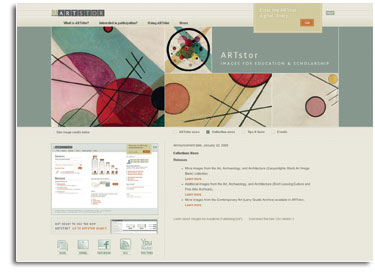ARTstor: Images and Tools for Teaching and Research
 The Libraries recently licensed ARTstor, an online collection of visual images integrated with a groundbreaking set of tools for research and instruction in all disciplines. It was first developed for art and architecture faculty ready to transition from photographic slides and prints to digital images. Subsequent additions to the database include images of value to other disciplines, and tools designed for anyone using images in research or instruction, even if existing ARTstor collections don’t yet include relevant material.
The Libraries recently licensed ARTstor, an online collection of visual images integrated with a groundbreaking set of tools for research and instruction in all disciplines. It was first developed for art and architecture faculty ready to transition from photographic slides and prints to digital images. Subsequent additions to the database include images of value to other disciplines, and tools designed for anyone using images in research or instruction, even if existing ARTstor collections don’t yet include relevant material.
This non-profit initiative, launched by the Mellon Foundation and sharing some tools with JSTOR, another Mellon Foundation resource, includes a growing menu of contributions from museums, collections, and universities worldwide. For instance, ARTStor’s pilot collections brought together images of cave grottos in the Gobi Desert with images of items removed from the grottos by explorers and held by museums in Western Europe.
To promote interdisciplinary use, ARTstor has created a series of guides suggesting creative uses of its collections. However, users can upload their own images, along with descriptive data, and create a personal collection that can be kept private or shared with students or colleagues using ARTstor’s powerful folder hierarchy.
For example, images can be organized into folders for future study or for lectures. You can give passwords to students or colleagues to access selected folders, and they in turn can create individual folders inside your folder. You can communicate with them by leaving notes on individual images and they can reply or add their own notes.
To view and analyze images, ARTstor has an online tool that allows zooming, rotating, downloading, and printing while maintaining high image quality. Multiple images can be compared side-by-side, and descriptive data and comments left in a shared folder can be displayed with the image to aid in analysis.
Finally, ARTstor has its own offline presentation tool similar to other slide-based presentation software but optimized for high-resolution images. Groups of images can be uploaded with a single click, and several slide formats allow zooming and panning during a presentation. Users can create, in as few as two mouse movements, slides where text, such as the title of the work, the artist’s name, and the date of creation, is added automatically.
For more information, contact Jeff Schneidewind, Manager, Interactive Learning Center (jhschnei@uci.edu or x47099) or Virginia Allison, Research Librarian for Visual Arts (v.allison@uci.edu or x40360).
Improved ANTPAC Display of Non-Roman Scripts
 A recent upgrade to ANTPAC has improved the searching and display of non-Roman languages. ANTPAC now fully supports Unicode, an international character-encoding standard designed to support the written texts of all of the world’s languages and scripts, including scientific, mathematical, and technical symbols.
A recent upgrade to ANTPAC has improved the searching and display of non-Roman languages. ANTPAC now fully supports Unicode, an international character-encoding standard designed to support the written texts of all of the world’s languages and scripts, including scientific, mathematical, and technical symbols.
We are now able to store and display all scripts and characters of the many languages in which the libraries collects, including Chinese, Japanese, Korean, Vietnamese and Arabic. This upgrade to ANTPAC fully converted our database of more than 2.4 million bibliographic records and authority records to this new standard.
For more information, contact Vicki Grahame, Acting Associate University Librarian for Technical Services (vgrahame@uci.edu or x47643).

